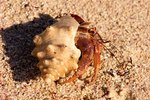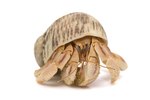
One of the many interesting things about hermit crabs is their shells. These little "mobile homes" are vital for all hermit crabs; they protect their soft abdomens as well as help crabs maintain a proper moisture level, which is crucial to their survival.
The Perfect Shell
Like all hermit crabs, Sheldon has a hard exoskeleton that covers all but his abdomen, which requires protection. His abdomen is very soft, making him vulnerable to predators, which is where the shell comes in. The perfect home allows him complete mobility and keeps him safe from predators. That means it has no holes and fits snugly, yet provides ample room to accommodate him if he needs to withdraw completely. The ideal shell also helps him maintain the right moisture level, which is key to his survival. It's easy to see why when Sheldon finds the right shell he's reluctant to leave it.
Trading In or Up
There's no rhyme or reason to why or when Sheldon will change his shell. Hermit-Crabs.com notes that the tiny Ecuadorian hermit crabs are known to be hesitant to change shells, while Caribbean crabs are much more willing to try out new digs. As crabs grow, they will need to change shells when they outgrow the old ones, but when they've stopped growing, it's often a matter of mood that determines when a crab will decide to go shopping for a new home. Some crabs will trade shells several times over a week -- or even a day -- if they're house-hunting. Other crabs will stay with what they know.
Molting: Often Time for a Different Shell
Hermit crabs grow through the molting process, and it's the most stressful time of a hermit crab's life. When Sheldon molts, he'll shed his old exoskeleton and wait for the new exoskeleton to harden up. During this time, he isn't able to move and has to wait to regain muscle control. Oddly enough, some crabs will seek out a smaller shell before they molt because after they've molted, the smaller shell will fit better. It will take as long as a month for the crab to get large enough to fill out a bigger shell. Some crabs don't change shells when they molt.
Encouraging Change
If Sheldon looks a little cramped, or hasn't changed shells in a long time, it's normal to wonder why he's so reluctant to move. You can try to encourage a switch by ensuring that he's got a nice variety of shells to choose from. If you provide different shapes of sufficient size, it might make him a little more willing to change. He'll need a shell that he can completely withdraw into; a basic guideline is to choose a shell with an opening about 1/8 inch larger around than the size of his large claw. You might also try boiling the shells to ensure there is no odor lingering that might be dissuading Sheldon from choosing a new residence. If you do this, make sure you don't have a little hermit crab hiding away in there! Finally, always avoid painted shells; the paint can chip off and poison Sheldon.
References
Photo Credits
-
Jeffrey Hamilton/Lifesize/Getty Images




